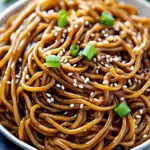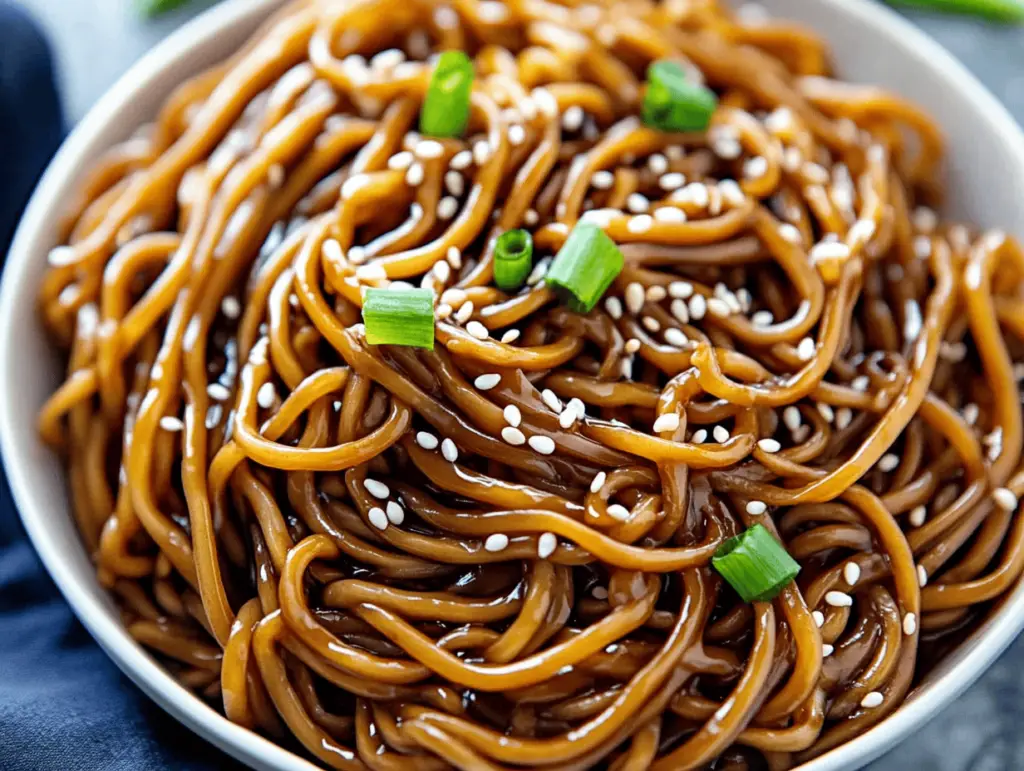If you’re tired of the same old takeout routine and long for the bold, savory flavors of hibachi cooking, then look no further! This delightful recipe for Hibachi Noodles is not only easy to prepare but also incredibly bursting with flavor, promising to elevate your weeknight dinners or special occasions. Made with fresh ingredients and cooked right on your stovetop, it’s a comforting meal that encapsulates the essence of Japanese cuisine. These noodles are versatile and can be paired with an array of proteins or vegetables to create a truly personalized dish. In this article, you’ll discover the secrets behind crafting perfect hibachi noodles at home, including ingredient insights, step-by-step cooking instructions, and tips for variation.
Understanding the Recipe
Hibachi cooking, which refers to the traditional Japanese method of grilling food over an open flame, often evokes memories of lively teppanyaki restaurants where chefs showcase their skills in front of guests. Hibachi Noodles stand out as a beloved component of this dining experience, renowned for their rich umami flavor and satisfying texture. This dish is unique because it strikes the perfect balance between simplicity and indulgence, making it suitable for both casual dinners and festive gatherings. In my own experience, preparing hibachi at home became a cherished family tradition. It brings everyone together, allowing for a celebratory atmosphere filled with laughter and delightful aromas. Throughout this article, you will learn how to recreate this comforting dish, ensuring a memorable meal every time.
Ingredient Breakdown
To create these incredible Hibachi Noodles, you’ll need the following ingredients:
- 1 lb yakisoba or linguine noodles (cooked al dente): The base of the dish, these noodles soak up the rich sauces and flavors beautifully, making them the perfect vehicle for the other ingredients.
- 3 tbsp butter: Used for sautéing, butter adds richness and a silky texture to the dish.
- 1 tbsp garlic, minced: Garlic imparts a wonderful aromatic flavor, enhancing the overall profile of the noodles.
- 1 tsp ginger, minced: Fresh ginger adds a warm, spicy undertone that complements the other flavors.
- 3 tbsp soy sauce: This essential ingredient brings a depth of flavor and umami punch that is characteristic of hibachi cooking.
- 1 tbsp teriyaki sauce: To add a hint of sweetness and more complexity to the flavor.
- 1 tbsp mirin (or rice vinegar): Provides a mild sweetness and acidity, brightening the dish.
- 2 tbsp brown sugar: This balances the saltiness of the soy sauce and deepens the flavor.
- Salt & pepper to taste: Essential seasonings to elevate the dish further.
- 1 tbsp sesame oil: Offers a nutty aroma and distinct taste, crucial for an authentic hibachi experience.
- 1 tbsp sesame seeds: Used as a garnish, they add a delightful crunch and appealing visual element.
- 2 green onions, chopped: Fresh green onions not only enhance the presentation but also add a fresh, mild onion flavor.
When preparing Hibachi Noodles, it’s crucial to select high-quality ingredients for the best results. Consider using whole wheat noodles or gluten-free options for dietary restrictions. You can also substitute the butter with plant-based alternatives like olive oil for a dairy-free version. The balance of flavors in this dish makes it a standout when paired with proteins like grilled chicken or sautéed vegetables for a more substantial meal.
Step-by-Step Instructions
Follow these detailed steps to craft your delicious Hibachi Noodles:
- Cook the noodles: In a large pot, bring salted water to a boil and add 1 lb yakisoba or linguine noodles. Cook according to the package instructions until al dente. Drain the noodles and set them aside.
- Sauté garlic and ginger: In a large wok or skillet, melt 3 tbsp butter over medium-high heat. Once melted, add 1 tbsp minced garlic and 1 tsp minced ginger. Sauté for about 1-2 minutes until fragrant but not browned.
- Prepare the sauce: While the garlic and ginger are cooking, in a separate bowl, mix together 3 tbsp soy sauce, 1 tbsp teriyaki sauce, 1 tbsp mirin (or rice vinegar), and 2 tbsp brown sugar. Stir until the sugar is dissolved.
- Add sauce to the wok: Pour the sauce mixture into the wok with the garlic and ginger. Allow it to simmer for 3-4 minutes, stirring occasionally, so the flavors meld together.
- Toss in noodles: Add the drained noodles to the wok, tossing them gently in the sauce to ensure they are well coated. Season with salt & pepper to taste.
- Finish with sesame oil: Drizzle 1 tbsp sesame oil over the noodles along with 1 tbsp sesame seeds. Toss again to combine and cook for another minute to heat through.
- Garnish and serve: Remove from heat and serve the noodles hot, garnished with 2 chopped green onions. Enjoy!
Variations and Customizations
The beauty of Hibachi Noodles lies in their versatility. Here are some customization ideas:
- Protein Pick: Try adding grilled chicken or sautéed shrimp to make the dish more substantial. For a vegetarian option, toss in stir-fried tofu or tempeh.
- Vegetable Medley: Include a mix of colorful vegetables, such as bell peppers, snap peas, and carrots, for added nutrition and crunch.
- Spicy Kick: If you enjoy heat, add a splash of sriracha or a pinch of red pepper flakes while cooking.
- Noodle Choice: Experiment with different types of noodles such as rice noodles or zucchini noodles for a gluten-free alternative.
- Herbal Infusion: Incorporate fresh herbs like cilantro or basil for an aromatic twist.
Serving Suggestions
Present your Hibachi Noodles beautifully for an appetizing look. Here are some suggestions:
- Garnishes: Top with extra sesame seeds and sliced green onions for a vibrant finish.
- Sides: Serve with grilled chicken, steak, or a selection of seasonal vegetables sautéed with soy sauce.
- Beverages: Pair with iced green tea or a refreshing cucumber lemonade to complement the flavors.
- Occasions: Perfect for family dinners, celebratory gatherings, or casual weekend lunches with friends.
Tips for Success
To ensure the best results while preparing your Hibachi Noodles, consider the following tips:
- Don’t Overcook the Noodles: It’s essential to cook your noodles just until al dente, as they will continue to cook when added to the hot wok.
- Prep Ahead: Have all your ingredients prepped and ready before starting, as the cooking process moves quickly.
- Storage: Leftover noodles can be stored in an airtight container in the refrigerator for up to 3 days. Reheat in a skillet over medium heat, adding a splash of water to regain moisture.
- Freezing: For long-term storage, you can freeze the cooked noodles and sauce separately, though it’s best consumed fresh for optimal texture.
FAQs
Here are some common questions regarding Hibachi Noodles:
- Can I substitute the noodles? Yes, you can use any noodles you prefer. Alternatives like rice noodles or gluten-free pasta work well.
- Is it possible to make this dish vegan? Absolutely! You can omit the butter and instead use olive oil or a vegan butter substitute. Additionally, replace any animal protein with tofu or additional vegetables.
- What if I don’t have mirin? You can replace mirin with rice vinegar combined with a small amount of sugar to mimic its sweetness.
- How should leftovers be stored? Keep any leftovers in an airtight container in the refrigerator for up to 3 days. Reheat gently on the stovetop or microwave.
- Can I make these noodles ahead of time? Yes, you can prep the noodles and sauce ahead. Store separately and combine just before serving, reheating everything together.
Conclusion
Making Hibachi Noodles at home is not only a simple and enjoyable cooking experience, but it also allows you to share an authentic taste of Japan with your loved ones. The combination of noodles, savory sauces, and delightful toppings creates a dish that is both comforting and versatile. As you explore the recipe outlined in this article—from understanding its rich background to experimenting with variations—you’ll see just how rewarding it is to create this hibachi favorite yourself. So gather your ingredients, fire up your wok, and get ready to impress everyone at your dining table with these fantastic homemade Hibachi Noodles!
Print
Hibachi Noodles
Description
Savor delicious hibachi noodles stir-fried with fresh veggies and your choice of protein. A quick and tasty main dish perfect for any meal.
Ingredients
- 1 lb yakisoba or linguine noodles (cooked al dente): The base of the dish, these noodles soak up the rich sauces and flavors beautifully, making them the perfect vehicle for the other ingredients.
- 3 tbsp butter: Used for sautéing, butter adds richness and a silky texture to the dish.
- 1 tbsp garlic, minced: Garlic imparts a wonderful aromatic flavor, enhancing the overall profile of the noodles.
- 1 tsp ginger, minced: Fresh ginger adds a warm, spicy undertone that complements the other flavors.
- 3 tbsp soy sauce: This essential ingredient brings a depth of flavor and umami punch that is characteristic of hibachi cooking.
- 1 tbsp teriyaki sauce: To add a hint of sweetness and more complexity to the flavor.
- 1 tbsp mirin (or rice vinegar): Provides a mild sweetness and acidity, brightening the dish.
- 2 tbsp brown sugar: This balances the saltiness of the soy sauce and deepens the flavor.
- Salt & pepper to taste: Essential seasonings to elevate the dish further.
- 1 tbsp sesame oil: Offers a nutty aroma and distinct taste, crucial for an authentic hibachi experience.
- 1 tbsp sesame seeds: Used as a garnish, they add a delightful crunch and appealing visual element.
- 2 green onions, chopped: Fresh green onions not only enhance the presentation but also add a fresh, mild onion flavor.
Instructions
- Cook the noodles: In a large pot, bring salted water to a boil and add 1 lb yakisoba or linguine noodles. Cook according to the package instructions until al dente. Drain the noodles and set them aside.
- Sauté garlic and ginger: In a large wok or skillet, melt 3 tbsp butter over medium-high heat. Once melted, add 1 tbsp minced garlic and 1 tsp minced ginger. Sauté for about 1-2 minutes until fragrant but not browned.
- Prepare the sauce: While the garlic and ginger are cooking, in a separate bowl, mix together 3 tbsp soy sauce, 1 tbsp teriyaki sauce, 1 tbsp mirin (or rice vinegar), and 2 tbsp brown sugar. Stir until the sugar is dissolved.
- Add sauce to the wok: Pour the sauce mixture into the wok with the garlic and ginger. Allow it to simmer for 3-4 minutes, stirring occasionally, so the flavors meld together.
- Toss in noodles: Add the drained noodles to the wok, tossing them gently in the sauce to ensure they are well coated. Season with salt & pepper to taste.
- Finish with sesame oil: Drizzle 1 tbsp sesame oil over the noodles along with 1 tbsp sesame seeds. Toss again to combine and cook for another minute to heat through.
- Garnish and serve: Remove from heat and serve the noodles hot, garnished with 2 chopped green onions. Enjoy!
